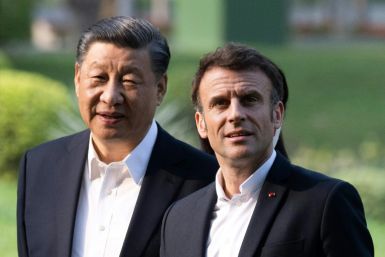China: Steadying And Back Chasing Commodities
No wonder Chinese companies are back in commodity markets, especially base metals and the best indicator of all, copper.
The country's huge manufacturing sector seems to have come through the mid-year slowdown in activity, judging by the two monthly surveys of the sector from the Government and from global bank, HSBC.
The official Purchasing Managers' Index (PMI) from the China Federation of Logistics and Purchasing rebounded to 50.9 in August from a 29-month low of 50.7 in July, according to figures out yesterday.
The August figure ended four consecutive months of decline, and also beat the preliminary forecast of 49.8 for the month by the HSBC survey.
(Remember a reading below 50 indicates contraction from the previous month, while a reading above 50 indicates expansion).
And the final HSBC's China Purchasing Managers' Index rose in August from July, but was still just under the 50 level.
The HSBC/Markit survey was 49.9 in August from 49.3 in July and 49.8 in the preliminary early report last week.
A notable result in both surveys was a fall in new orders, especially in the official report.
It showed the new export order index falling to 48.3 in August, signalling a contraction, from 50.4 in July.
The HSBC survey showed a fall in the new orders sub-index fell which dipped below 50 for the first time since July 2010, while the sub-index for new export orders showed a slight improvement in August but was still under the 50 level for the 4th month in a row.
In both cases the weak demand from Europe and the US were blamed.
Both output and employment in the HSBC survey rebounded to above the 50 line for the first time in three months.
"These data confirm our view that China will only see growth moderation in the coming months, rather than a hard landing," said Qu Hongbin, an HSBC economist said in a statement.
HSBC's survey says at the current level, China's industrial production is running at a 13% to 14% range, where it has been for most of the year.
With no sign of a further contraction in manufacturing and solid domestic demand, it's no wonder Chinese buyers have appeared in commodity markets in the past month to take advantage of the big price falls in early August.
As a result copper prices up 10% in the past three weeks, iron ore prices at three month highs and coal prices are still firm.
Copper and iron ore prices are the best indicators of Chinese sentiment about economic growth.
China consumes 38% of the world's copper production, and it produces around 46% of monthly steel output, absorbing by far the greatest proportion of sea traded iron ore shipments from Australia, India and Brazil: imports are running at well over 50 million tonnes a month at the moment.
China's return to the copper market is a reversal of the first half of this year when consumers ran down stocks and cut purchases and imports as the central government tightened credit and lifted interest rates to cool the economy.
As the two PMI surveys show, Chinese industrial production has stabilised around an annual growth rate in the range of 13 to 14%.
Copper prices fell to an 8-month low of $8,446 a tonne in the commodity sell off in early August, but since then prices have risen more than 10% to $US9,275 a tonne on the LME overnight on Wednesday as Chinese buyers again appeared to buy at these lower prices.
Comex copper in New York has made similar gains in the closing fortnight of August, but still ended the month with a loss of 6.3%, which seems to have been enough to tempt Chinese buyers back into dealing.
China's net copper imports in the first seven months of this year fell 37% from the same period in 2010 (as global prices topped at all time highs well above $US10,000 a tonne on the London Metal Exchange) as consumers cut their purchases.
Iron ore imports plunged to 47 million tonnes in February (helped by holidays), but have bounced back to the 54 million tonne level as daily steel production hovers around the 1.9 million tonnes a day mark (It hit an all time high of just over 2 million tonnes a day in June and a record monthly total of more than 60 million tonnes).
As we pointed out last week in the Weekly, iron ore, the other great indicator (well, it's steel, more accurately) continues to enjoy solid prices, despite forecasts of a decline in the third quarter and half year.
In fact world spot iron ore prices hit three month highs last week and spot contract prices will run at those levels until the end of the year.
Reuters forecast this week that the likes of BHP Billiton, Vale of Brazil and Rio Tinto will keep global iron ore prices steady in the 4th quarter.
"Based on Platts index prices for June to August, which top iron ore miners such as Vale and Rio Tinto use in fixing fourth-quarter contract prices, the 62-percent grade averaged $175.63 a tonne, cost and freight, down marginally from $176.96 in March-May, the basis for third-quarter pricing," Reuters said (All US dollars).
"Contract prices jumped 20 percent to a record $179.24 in the second quarter, based on Platts index prices for December-February, as booming demand from top consumer China helped spot prices surge to a record of nearly $200 a tonne in mid-February.
"Platts-based spot prices averaged $179 in August, up from $175.26 in July, amid weakness in other commodity markets fuelled by worries over a struggling U.S. economy and a crippling debt crisis in Europe."
And a report on the Xinhua newsagency website this week said that China's steelmakers saw their profits dented by surging iron ore prices in the first half of the year, according to preliminary statistics.
"Twenty-seven listed Chinese steel producers released their H1 results as of Monday night. Their combined net profits slumped 15.7 percent year-on-year to 9.98 billion Yuan (1.56 billion U.S. dollars), according to Wind Information, a Shanghai-based financial data provider.
"Of the 27 listed steel companies, 16 reported lower profit margins, accounting for 59.3 percent of the total, the Economic Information Daily quoted an unnamed steel analyst from CITIC Securities as saying on Tuesday."
China imported 334 million metric tons of iron ore in the six months to June, up 8.1% on the same period last year, according to official data. The average price for iron ore increased by 42.4% year-on-year to $US161 a tonne.
China's steel output rose 9.6% year-on-year in the first half to 350 million tonnes, but the country's Ministry of Industry and Information Technology said the industry's profit margins dropped to 2.42% in the first five months, the lowest in for more than five years.
Steel output has seen little impact so far from the government's tighter credit conditions, power shortages and attempts to cut pollution and energy consumption.
A senior executive from Rio Tinto yesterday forecast the iron ore boom would continue for a while yet. He told a conference in Perth that global demand would rise by 100 million tonnes a year for the next eight years, meaning production will almost double in that time.
The resources boom will go on and on, if that's the case.
Copyright Australasian Investment Review.
AIR publishes a weekly magazine. Subscriptions are free at www.aireview.com.au






